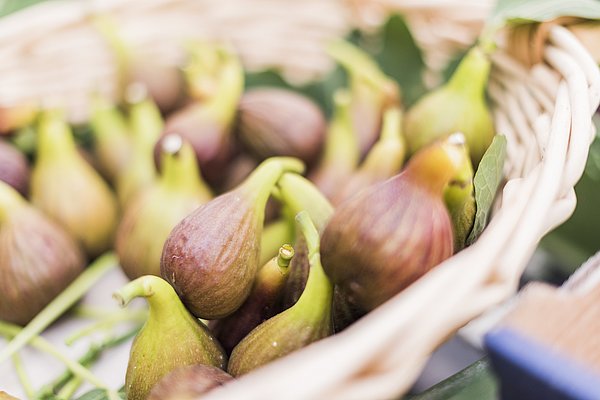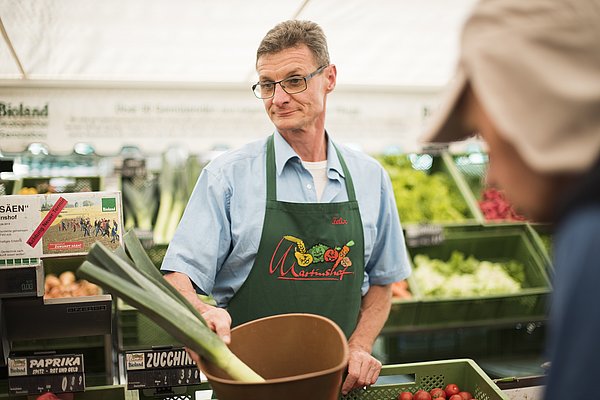

“Just follow the people with the shopping trolleys!” This is the reply I get from a grinning passer-by when I ask how to get to the weekly market in the town of Neustadt. It’s Saturday; I’ve just arrived in the Palatinate and I’m hungry. The sun is shining and I’m on the hunt for some breakfast.
Text: Hendrik Haase

When I travel, my first instinct is usually to seek out the regional weekly markets. This isn’t just because I often get off the plane or train hungry, but rather because such markets are a fabulous opportunity to immerse oneself in the lifestyle of any region. Here, each special terroir can be sensed, experienced and – best of all – tasted. Delving into the hustle and bustle of a weekly market, you suddenly find yourself in a microcosm of society; you hear languages and dialects and establish your first “live” point of contact with the culture that surrounds you.
In a time when the same old brand adverts are lit up in nearly every town centre, I can still often find a flavour of the genuine, the typical and the unique at the market stalls run by farmers and traders. This is just as true for the marketplace (Marktplatz) in Neustadt an der Weinstraße as it is for the floating markets in the Mekong Delta or the Piazza Palazzo in Turin.
As I now weave my way through the Old Town, I’m not just following housewives carrying empty shopping bags, but also the chimes of a church bell. It can’t be much further to go. Behind the next corner, in the shadow of an imposing Gothic church, the market’s bustle suddenly begins. Colourful stalls fill the historic market square, framed by a multitude of beautifully restored timber-framed houses. On a first foray into the narrow alleys between the busy stalls, I’m struck by the abundance of produce that now spreads out before me. The displays overflow with variety, boasting a wide range of different fruits, vegetables, herbs and flowers. I simply can’t pass by many of the crates without quickly getting stuck in to have a sniff at the plants, some of which I don’t recognise.

The first morsel I sample is a fresh fig, which tastes so sweet that I can scarcely believe it was picked by the farmer just around the corner from here. I sink my teeth into crimson raspberries at the next stall, smell a fresh, violet artichoke blossom and even find a wooden crate full of little kiwis at the end of the row. As someone who usually wanders the weekly markets of Berlin, I’m in awe of this almost Mediterranean wealth of regional produce. A little later on, I chat with the growers and find out why this comparison is not so wide of the mark after all. A total of 2,000 hours of sunshine a year in the Palatinate make it one of the warmest climate zones north of the Alps and ensure that an unexpectedly rich variety of fruits and vegetables flourishes here – not to mention unique wines. The nearby Haardt mountain range acts like a giant wall to protect the hills of the Wine Route and the depressions of the Rhine Valley against the rain which drenches the Palatinate Forest, but wears itself out before reaching the Riesling, figs and cauliflower next door.
After taking a quick sip of the freshly brewed coffee I bought from the back of a three-wheeled scooter, I start to hunt for some breakfast. The first thing I come across is a wonderful local goat’s cheese. It isn’t long before I find some crusty, hand-baked bread to go with this, not to mention the classic Palatinate “Saumaache” sausage from the aptly named “Saumagenparadies” (Pig Stomach Paradise); it has a wonderful, savoury taste, whether enjoyed hot or cold. A short walk from the butcher’s, I even find some fine pastries at a stall run by a Frenchman. I note just how effortlessly this Francophile influence blends in with the market’s local Palatine flair. It is this precise fact that allows me to enjoy the delicate, playful specialities from neighbouring Alsace side by side with the rustic, local delights of the Palatinate for my hotchpotch breakfast. A glass of Riesling is all that’s really missing from the picture, but the day is still young and I’ll be heading to a winery later on. However, my hunger has been sated for the time being and I’ve certainly replenished my stomach sufficiently for a copious wine tasting.
The next order of business is to search for ingredients for dinner. This is where my chef’s eye comes in. But what will it be today? At weekly markets in particular, it’s worth having slightly flexible recipes when you’re buying produce. Whoever sticks rigidly to the recipe and searches for “200 g carrots” might easily miss the crisp, fresh chard that’s currently in season. Likewise, anyone who slavishly runs around following Jamie Oliver’s instructions might dash straight past the special regional produce and foodstuffs that you won’t find in any recipes. Thankfully, my collection of cookbooks is still standing on the shelf at home, clearing the way for me to spontaneously decide what will end up in my pot this evening. I’m able to let my nose lead the way.


Here at the market stand of the Akazienhof in Neustadt...
The first thing I find is some oil from a meadow plant, which smells of freshly mowed grass with a hint of dandelion. As the oil dealer drizzles a little of it onto my hand to taste, I feel my palate being reminded of my grandma’s pea soup. “That’s camelina oil,” he tells me. “It’s re-cultivated in this region and then pressed in Hauenstein, in the Palatinate Forest.” The oil is supposed to be the perfect accompaniment to salads and boiled potatoes. A little phial of the stuff goes straight in my pocket.
Two stalls further on, I stumble across some potatoes with delicate golden skins; they practically jump out at me from their crate. Perfect for boiling – and ideal for making “papas arrugadas”, the Mediterranean variant with a wonderfully crisp, salty crust and the skins left on. The word “potato” provides for some amusement on the stall, however. “You mean ‘Grumbeere’! That’s what they’re called in these parts!” My vocabulary is corrected by the lady behind the counter as I pass her the paper bag I’ve used to collect so many of the little “earth berries” in. I learn that she isn’t just a market trader, but also an organic farmer. “The meat and sausages are all from our organic farm,” she explains proudly to this curious visitor. “I even baked the bread myself!” After chatting with her a little, I get an invitation to call by the farm and see where the pork chop that just landed in my jute bag was reared.
A few hours later, I’m standing outside the walls of Neustadt in a green meadow, where my feet are being examined by some inquisitive snouts. “Pigs need to be able to put their snuffling to good use,” says the farmer standing next to me in his vest. “Just like wild boar, they want to wallow about in the muck and cover themselves in it.” This is perfectly reasonable in the midday sun, I think to myself. When I accepted the invitation from the farmer at the market, I didn’t yet realise just how quickly you can arrive at your shopping’s provenance in the Palatinate. Now, the pork I bought is gambolling around the waist-high grass right before my eyes. “A pig needs coarse fodder, alfalfa, potatoes, carrots and grass,” farmer Bernd Naumer explains to me. In other words, no imported soya, antibiotics or whatever else is often added to feed these days. The “Akazienhof” is an organic farm – and Mr Naumer is a proud organic pig farmer. He’s absolutely convinced of his approach: “All you need to do is observe nature, understand it and then copy it.” The freedom of movement and natural feed that his organic pigs enjoy mean that they might grow a little more slowly than their over-cultivated supermarket cousins, but their taste is much more succulent and flavoursome when they finally get to market. Naturally, this means that much more of the pork chop remains after being fried, as the meat doesn’t lose any of its moisture in the pan.
Just like their vegetables and home-baked bread, in the family's view, the meat is much more than just a product to be sold to customers on the market every week; this much quickly becomes clear. The foodstuffs that they produce here require a great deal of effort, passion and conviction. “We know of 20 vitamins and 118 elements in the periodic table,” farmer Bernd tells me at the end of my visit, “yet there are over 100,000 secondary plant substances and it is assumed that 50,000 of these are important for humans.” These are substances that are best enjoyed as fresh as possible and in all their diversity. What better place could there possibly be to search for such products than the weekly markets in the Palatinate, I think to myself. After all, it is one of the largest arable regions in Germany

On the way back, I turn my gaze once more to the things I’ve bought today. I’m now going to use these to whip up a fantastic dinner in my holiday apartment’s kitchen. The whole day long, I’ve been snacking on the crisp leaves of the ice plant: these are plump, covered in little beads of water and burst on the tongue when bitten into. In actual fact, this plant is usually found only in the Mediterranean, the Canary Islands, the Azores or Madeira. These are all places that evoke a sense of sunshine or of holidays; of laid tables bursting with culinary sensations. Together with many other unexpected delights, I bought the ice plant today at the weekly market along the German Wine Route: a region that is second to none and which rewards explorers with its bounty. Simple, hearty produce is sometimes so close at hand that you just need to dare to dive in and follow your nose.
Markets along the German Wine Route